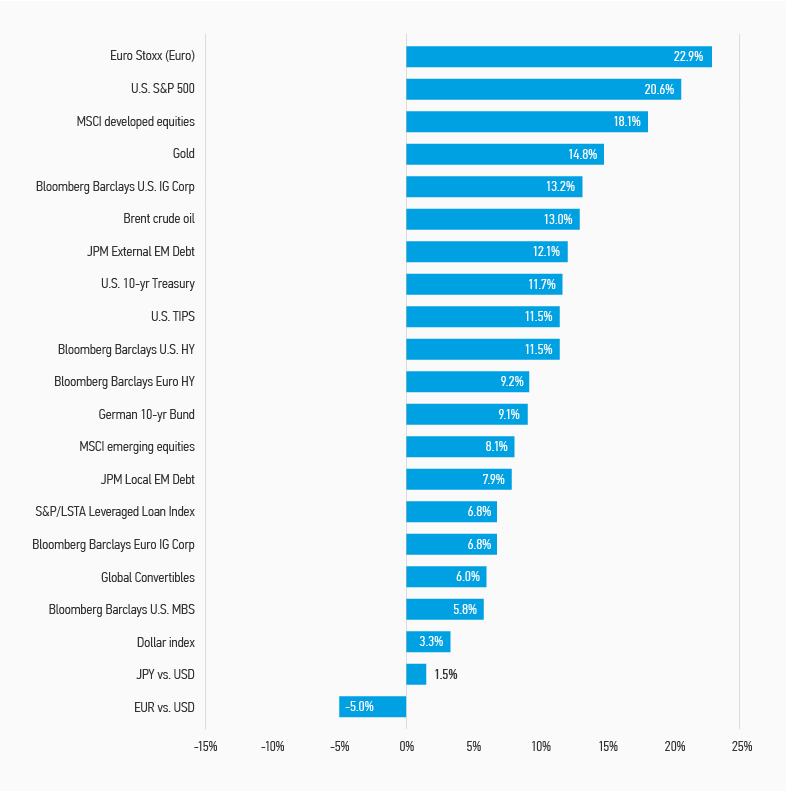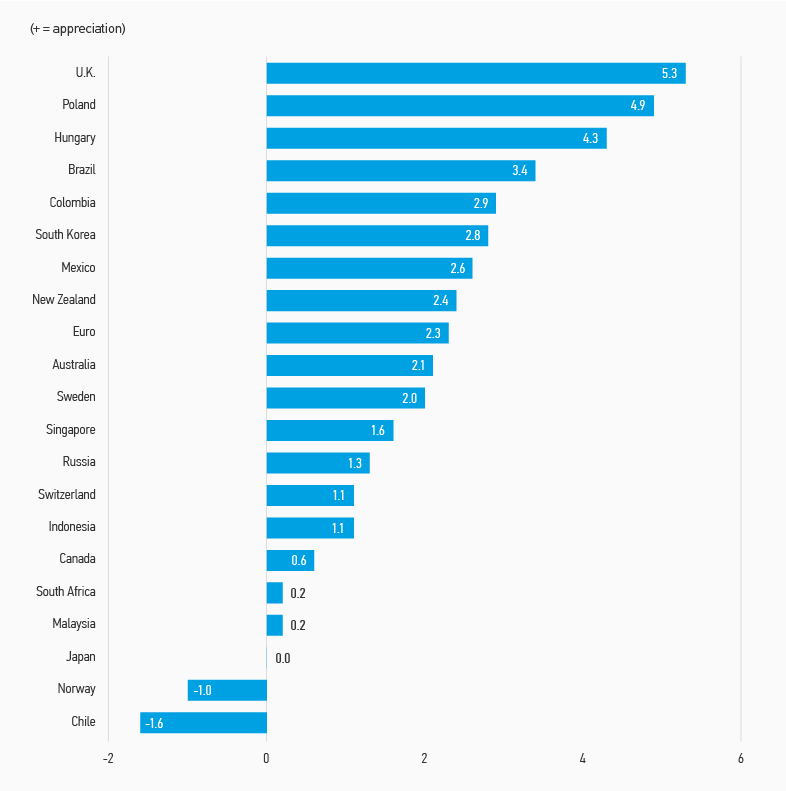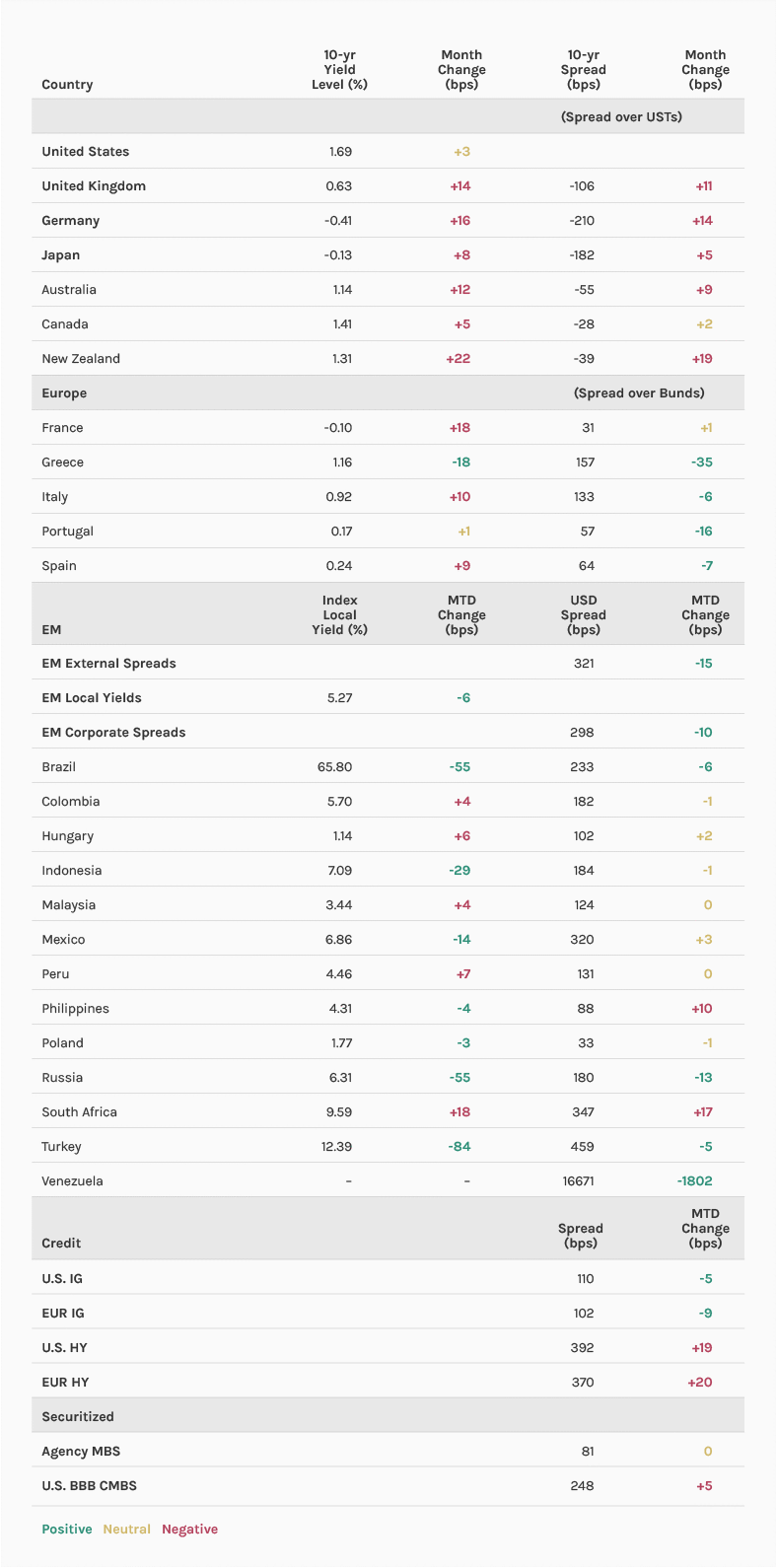
Morgan Stanley: Normalization continues
In many ways, October was a continuation of the developments that started in September. Government bond yields rose on better (although still far from good) economic news; political risks receded further as significant negatives (i.e., the U.S./China trade dispute and Brexit) eased.
27.11.2019 | 12:52 Uhr
With no further evidence of additional monetary policy easing around the world, it was not surprising that bond yields drifted upward, although in a quite ragged pattern, prolonging investors’ whiplash-like experience. What we are experiencing is a lot of high-frequency volatility with little evidence of a trend. This experience is likely to continue as we approach a fork in the road: data will get better as geopolitical risks will recede, or we will return to trade war concerns and deteriorating economic fundamentals.
This ragged performance also permeated credit markets. Investment grade spreads narrowed and emerging market yields fell, which we found to be appropriate when considering the better economics and geopolitics. Surprisingly, U.S. high yield spreads widened even as U.S. equities made new highs. All we can do is reiterate last month’s advice: be close to home (e.g., neutral) with a small optimistic bias. Keep risks balanced, not too much rate risk, not too much credit risk. And focus on bottom up security and country selection where fundamentals are sound and valuations are reasonable.
Display 1: Asset Performance Year-To-Date



The developed bond market sell off that began in September continued in the second half of October, with non-U.S. yields again hit the hardest. This time the culprit can be laid at the door of two factors:
- Better economic data, generally speaking, or at least optimism that data was troughing; and
- Growing optimism that the U.S. and China would cut a trade deal, ending, at least for now, risks of escalation.
We are cautiously optimistic that the market is correct in starting to price a bottoming of the economic data. In our minds, this optimism is based on two interrelated factors, factors that investors should always remember. First, economic data does not deteriorate forever. Trip wires are triggered which endogenously slow the descent, especially when there are no obvious large imbalances in the world. Second, and distinctly related to the first, monetary policy globally has eased substantially in 2019. This is a normal policy response to a deterioration in economic conditions, both current and expected.
The U.S. monetary policy response has been significant and unusual in that unemployment is at record lows, unemployment claims are not rising, the economy is growing, and inflation is not falling. The Federal Reserve (Fed) has never before cut rates three times in such conditions. Their actions are truly pre-emptive and should significantly improve the chances of an acceleration of growth in 2020. Other central bank responses have not been so out of character and can, in some ways, be viewed as lagged responses to actual deterioration in economic conditions. But the bottom line is that economies now have a lot more support than they did 12 months ago, and no recession is likely for the foreseeable future. If only that pesky trade war would go away.
However, let’s not get too carried away with our optimism, there are many potholes in the road ahead. Evidence of a growth turnaround is still scarce. Trend growth has fallen. R* (the full employment real interest rate) has fallen along with growth. Capex is still weak as the long-term U.S./China relationship remains to be decided and animal spirits are definitely scarce. Moreover, while manufacturing/industrial activity may be bottoming, the service side of the global economy is still gently weakening. Since this is a much larger share of the global economy, if services do not turn around in the months ahead, our optimism might be misplaced. Labor markets, as we have discussed in the past, remain key. If household economies continue to grow, we are alright. Otherwise, expect more rate cuts.
The outlook for monetary policy is probably the easiest to predict, at least in the short term. Rates are low and they are going to stay low. The hurdle to raise rates is much higher than it is to cut them. For now, central banks have done their duty. They responded in what we would call a fairly aggressive way to actual slowdowns and risks of further economic deterioration. We expect no further changes in the fourth quarter and probably in the first quarter of next year as well. It will take time to see how effective this year’s rate cuts have been and how the U.S./China trade negotiations and Brexit develop. In the interim, expect to see data dependency and vigilance being the watch words. And, since further rate cuts are likely to be in response to worse data, they might not be so benignly interpreted by financial markets, meaning while bad news = rate cuts, this does not mean rate cuts = equity/high yield rallies. Bad news is bad news.
During this period of intense uncertainty, we continue to look for signs/indicators showing how the situation is going to evolve. We continue to believe the yield curve is the best barometer of market confidence. We think a measure of success, e.g., reflation, would be a steepening of yield curves. If monetary stimulus is working its magic, curves should steepen.
In the short term, we seem to be coming into a period of greater calm. The U.S. and China appear close to a “Phase 1” deal; a hard Brexit is seemingly off the table. No global recession. All we can do is reiterate last month’s advice. Be close to home (e.g., neutral) with a small optimistic bias. Keep risks balanced, not too much rate risk, not too much credit risk. Yields and credit are buys on weakness. And focus on bottom up security and country selection where fundamentals are sound and valuations are reasonable.
Developed Market (DM) Rate/Foreign Currency (FX)
Monthly Review:
Following in September’s footsteps, developed market sovereign bonds sold off again in October. While there was a slew of worse-than-expected economic data in the U.S. and Europe during the first half of the month, geopolitical risks, such as U.S./China trade negotiations and a no-deal Brexit eased toward the end of the month.
The Federal Open Market Committee (FOMC) had a very busy October between its meeting, releasing minutes from the September meeting, and announcing a new program to buy Treasury bills in order to alleviate stress in the short-term funding markets. At its October meeting, the FOMC cut interest rates by 25 basis points, lowering the federal funds rate to a range of 1.50%-1.75%. The third “insurance” cut of the year was widely anticipated by the markets, but now the question is what will the FOMC do next? Comments from various Fed members suggest the Fed is on hold indefinitely, through at least until 2020, unless economic conditions deteriorate significantly. Data wise, ISM numbers in the U.S. fell to its lowest level in 10 years, with U.S./China trade tension one of the driving forces of the lower than expected reading.1
Outlook:
Global growth is likely to continue to be lower for the remainder of 2019. Central banks have become more accommodative, particularly in the U.S. and eurozone, but additional accommodatory measures seem unlikely unless the macro deteriorate significantly. The three major risks we see to the outlook are Brexit, U.S./China trade disputes, and the weakness in the manufacturing and trade sectors undermining the consumer. In this context, we expect U.S. Treasury yields to remain below 2%.
Emerging Market (EM) Rate/FX
Monthly Review:
Emerging markets (EM) fixed income asset performance was positive in the month as improving risk appetite more than offset the negative impact of higher 10-year U.S. Treasury yields.2 The better sentiment was attributed to an improvement in the geopolitical tone as Brexit was delayed and the U.S. and China made progress in trade negotiations. Also contributing to the positive momentum were some signs of stabilization in global economic growth as September data from China showed stabilization in credit growth, improvement in PMIs, increased investment, and better housing and retail sales. Within domestic debt, both local rate returns and EM currency strength versus the U.S. dollar contributed to performance. During the period, commodity prices generally rose, with energy prices leading the way, followed by agricultural commodities, and mixed results from metals prices as base metal prices slipped. Investors continued to add to the EM debt asset class, funneling a total of $3.2 billion into EM debt strategies, with the majority of flows going to hard currency strategies ($2.4 billion) and the remaining $0.8 billion going to local currency strategies.3
Outlook:
EM debt could benefit in the near term if progress is seen in the U.S./China trade talks and/or there was further evidence of stabilization in global economic activity. Our baseline scenario envisions a successful signing of the “Phase 1” agreement between Presidents Trump and Xi, though its timing is now less certain, following Chile’s cancelation of the APEC summit in mid-November. There could be incentives for both sides to agree on a trade truce. From the U.S. perspective, proximity of presidential elections and the pressure from business lobbies/consumers to delay the application of further tariffs on imports from China. From China’s point of view, though a “Phase 1” limited deal does not include tariff rollback provisions, it may allow both sides to focus on other issues that are more important to China, e.g., Huawei, at a relatively low cost in terms of concessions. On the economic activity front, high-frequency indicators point to an incipient stabilization in EM growth, which, if confirmed by upcoming soft data, could boost risk appetite in the short term. Key risks to our near-term outlook stem from U.S. politics, as the impeachment inquiry shifts to a more public phase that could lead to heightened volatility.
Credit
Monthly Review:
October saw corporate spreads tighter, with the rally broad-based. Risk-free yields ended the month higher, continuing to reverse the move in August. The key drivers in October were:
- The European Central Bank (ECB) QE announcement due to start on November 1 at 20 Bn per month,
- U.S./China trade negotiations that edged towards a “Phase 1” agreement expected to be signed in November,
- Q3 corporate reporting that was better than lowered expectations, and
- Economic data that, while still weak, exceeded expectations. The U.S. rate cut at the end of the month confirmed the consensus view that easy monetary policy will last for the foreseeable future.
Outlook:
We are carefully monitoring the incoming economic data (with heightened focus on employment trends) as well as comments from central banks. While easy financial conditions support low default rates and technical demand likely creates positive momentum over Q4, credit spreads are close to the long run average. Q2/Q3-to-date corporate reporting did not signal weakness but, looking forward, we wait to see whether the weaker economic growth and forward-looking surveys are reflected in Q4 results. Our strategy has been to take profits on long-held positions pre-summer as spreads move below the long-run average, but we remain net long risk, looking to be tactical over the remainder of the year, with a bias to sell into expected strength.
Securitized
Monthly Review:
Rates continued to rise in October as economic conditions and geo-political risks seem to be improving. U.S. consumer economic conditions remain stable, with historically low unemployment, rising wages, and healthy spending rates, and increasing home sales continuing to be buoyed by lower mortgage rates. Securitized credit spreads were largely unchanged in October across both agency Mortgage Backed Securities (MBS) and credit sectors. Current coupon agency MBS nominal spreads tightened 1 basis point in October to 100 basis points above interpolated U.S. Treasuries.4 The Bloomberg Barclays U.S. MBS Index returned 0.28% for the month, and has returned 5.97% year to date. The duration of the Bloomberg Barclays U.S. MBS Index lengthened 0.13 years to 2.86 years during October.5 National mortgage rates rose 3 basis points in October to 3.75%, but remain very low by historical comparison; with mortgage rates 33 basis points lower in 2019 and 100 basis points lower than a year ago.6 Pay-ups for specified pools remain strong as investors look for pools with lower prepayment risks. The Fed MBS portfolio shrank by $21 billion during October to $1.446 trillion and is now $191 billion lower year to date.7 Mortgage mutual funds saw net inflows of roughly $1 billion in October, increasing year-to-date net inflows to roughly $14 billion.8 Primary dealer holdings of agency MBS remain at an elevated level of $50 billion, down from $70 billion at the end of September, but still well above a more historically normal holding level of $10-$30 billion.9 The combination of the continued reduction of the Fed’s MBS holdings and probable reduction of primary dealer MBS holdings could create a significant supply-demand headwind for agency MBS performance going into year-end.
Outlook:
Our outlook remains largely unchanged. We still have a positive fundamental credit outlook for residential and consumer credit conditions in both the U.S. and Europe. We remain slightly negative on agency MBS, which is under pressure from both increased prepayment risks from lower mortgage rates and also from the continued supply-demand dynamics from the Fed continuing to reduce its MBS holdings and bloated primary dealer inventories. Agency MBS spreads have widened materially over the past few months reflecting these risks and now offer more comparable relative value, but the supply pressure will likely remain in place going into year end.
1 Source: Bloomberg, as of October 31, 2019.
2 Source: Bloomberg, as of October 31, 2019.
3 Source: J.P. Morgan, as of October 31, 2019
4 Source: J.P. Morgan. Data as of October 31, 2019.
5 Source: Bloomberg. Data as of October 31, 2019.
6 Source: Bankrate.com. Data as of October 31, 2019.
7 Source: Federal Reserve Bank of New York. Data as of October 31, 2019.
8 Source: Lipper U.S. Fund Flows. Data as of October 31, 2019.
9 Source: Bloomberg. Data as of October 31, 2019.
RISK CONSIDERATIONS
Fixed-income securities are subject to the ability of an issuer to make timely principal and interest payments (credit risk), changes in interest rates (interest-rate risk), the creditworthiness of the issuer and general market liquidity (market risk). In a rising interest-rate environment, bond prices may fall and may result in periods of volatility and increased portfolio redemptions. In a declining interest-rate environment, the portfolio may generate less income. Longer-term securities may be more sensitive to interest rate changes. Certain U.S. government securities purchased by the strategy, such as those issued by Fannie Mae and Freddie Mac, are not backed by the full faith and credit of the U.S. It is possible that these issuers will not have the funds to meet their payment obligations in the future. Public bank loans are subject to liquidity risk and the credit risks of lower-rated securities. High-yield securities (junk bonds) are lower-rated securities that may have a higher degree of credit and liquidity risk. Sovereign debt securities are subject to default risk. Mortgage- and asset-backed securities are sensitive to early prepayment risk and a higher risk of default, and may be hard to value and difficult to sell (liquidity risk). They are also subject to credit, market and interest rate risks. The currency market is highly volatile. Prices in these markets are influenced by, among other things, changing supply and demand for a particular currency; trade; fiscal, money and domestic or foreign exchange control programs and policies; and changes in domestic and foreign interest rates. Investments in foreign markets entail special risks such as currency, political, economic and market risks. The risks of investing in emerging market countries are greater than the risks generally associated with foreign investments. Derivative instruments may disproportionately increase losses and have a significant impact on performance. They also may be subject to counterparty, liquidity, valuation, correlation and market risks. Restricted and illiquid securities may be more difficult to sell and value than publicly traded securities (liquidity risk). Due to the possibility that prepayments will alter the cash flows on collateralized mortgage obligations (CMOs), it is not possible to determine in advance their final maturity date or average life. In addition, if the collateral securing the CMOs or any third-party guarantees are insufficient to make payments, the portfolio could sustain a loss.




Diesen Beitrag teilen: